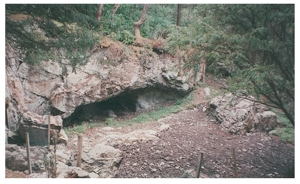
Historic Mining
 The earliest evidence of metal mining in Ireland is provided by Bronze Age copper workings at Ross Island, Co. Kerry in southwest Ireland. These workings, dated at between 2,400 and 2,000 BC (OBrien, 1996) constitute the oldest recognised in northwest Europe. Few records remain of mining activity prior to the major period of mining in the 19th century. Sparse texts attest to iron working at Avoca (Co. Wicklow) in the 2nd century, to iron and copper mines in the 9th century, alum mining in the 12th century and lead-silver workings and copper mining around 1500. Better information exists for the 16th and 17th centuries, when small-scale iron workings are known to have flourished across the eastern half of Ireland. The iron ores exploited included gossans from Avoca, carbonate ore (ironstones) from the coalfields and the widespread bog iron ore. By the early 1700s, the iron industry was much reduced in Ireland, primarily due to the exhaustion of timber supplies, that were used in the production of charcoal for smelting.
The earliest evidence of metal mining in Ireland is provided by Bronze Age copper workings at Ross Island, Co. Kerry in southwest Ireland. These workings, dated at between 2,400 and 2,000 BC (OBrien, 1996) constitute the oldest recognised in northwest Europe. Few records remain of mining activity prior to the major period of mining in the 19th century. Sparse texts attest to iron working at Avoca (Co. Wicklow) in the 2nd century, to iron and copper mines in the 9th century, alum mining in the 12th century and lead-silver workings and copper mining around 1500. Better information exists for the 16th and 17th centuries, when small-scale iron workings are known to have flourished across the eastern half of Ireland. The iron ores exploited included gossans from Avoca, carbonate ore (ironstones) from the coalfields and the widespread bog iron ore. By the early 1700s, the iron industry was much reduced in Ireland, primarily due to the exhaustion of timber supplies, that were used in the production of charcoal for smelting.
The Irish mining industry flowered in the late 18th and 19th centuries, triggered by the needs of the Industrial Revolution in Britain. Copper mining boomed in southwest Ireland, especially at Allihies, and there was significant exploitation of lead, copper (e.g. Avoca) silver, coal, barite, manganese and slate elsewhere (See Cole, 1922, for a detailed inventory of all sites from which extraction took place). Much of the metal mining was sporadic and small-scale and there was a tendency to mine only the coarse-grained, metallurgically clean ores that could be manually cobbed.
The late 18th century also witnessed a local gold rush in Co. Wicklow. For six weeks in 1795, some 80kg of alluvial gold is estimated to have been recovered from what subsequently became known as the Gold Mines River. Following State intervention and dispersal of the gold diggers, mining was subsequently carried out by the Government (1796-1803), by the local populace (1804-39), and by a private company (1860). The total amount of gold recovered is calculated at some 300kg, although the true figure may be much higher.
The fall in metal prices ca 1880, caused the Irish mining industry to enter a period of prolonged depression. Up to the 1950s, the only mining of note was a period of bauxite production in Northern Ireland, pyrite for sulphur from Avoca, phosphate from the west of Ireland, barite from Benbulben (1942-1960), and gypsum mining from the Kingscourt area (1936 onwards). Mining of thin coal seams also continued from the Arigna, Rossmore and Ballingarry areas.
References:
Cole, G.A.J. 1922. Memoir and Map of Localities of Minerals of Economic Importance and Metalliferous Mines in Ireland. Memoirs of the Geological Survey of Ireland, 155pp.
O'Brien, W. 1996 From the Fiery Furnace: copper sources and early Irish metallurgy. Royal Dublin Society, Occasional Paper 12, 16pp.
Mining Data
EMD records include manuscript information on mine production of copper and coal from the eighteenth century until the nineteen sixties. This was collected by the Geological Survey over many years from a wide variety of sources, and we are pleased to be able to make it available. The data may be freely used but no warranty is being given as to its accuracy, since such information is inevitably of variable quality. If anyone wishes to provide improved data, we will be pleased to incorporate it with due acknowledgement of the source. It can be accessed and downloaded as Excel spreadsheets, including graphical presentations.
historic coal data
historic copper data
